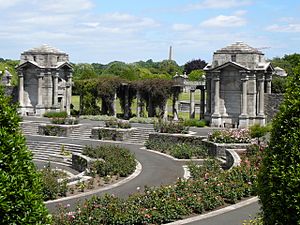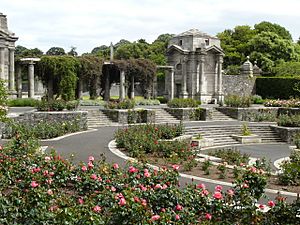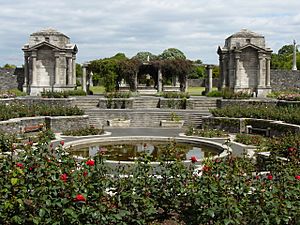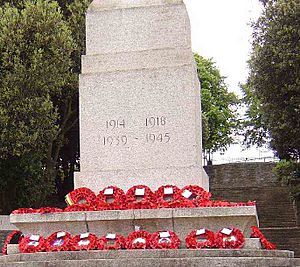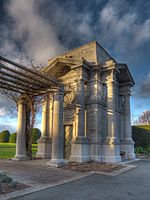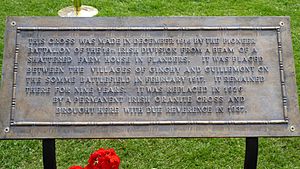Irish National War Memorial Gardens facts for kids
The Irish National War Memorial Gardens (Irish: Gairdíní Náisiúnta Cuimhneacháin Cogaidh na hÉireann) is a special place in Islandbridge, Dublin. It remembers the 49,400 Irish soldiers who died in World War I, also known as the Great War, between 1914 and 1918. More than 300,000 Irish people served in different armies during that war.
The Gardens also honor all other Irish men and women. They served, fought, and died in Irish groups within the Allied armies. These included soldiers from the British, Canadian, Australian, New Zealand, South African, and United States armies. They all helped the Allies in their fight against the Central Powers.
Contents
History of the Gardens
Planning the Memorial
After World War I ended, people wanted to create a lasting memorial. On July 17, 1919, over 100 people from all over Ireland met. They set up a special fund to plan a memorial for all Irish people who died in the war.
In November 1924, a committee was formed to find a place for the memorial in Dublin. At first, places like Merrion Square or St Stephen's Green were suggested. However, they couldn't agree on a spot.
Choosing the Location
W. T. Cosgrave, who was the leader of the Irish Free State (the government at the time), really wanted the memorial to be built. He appointed Cecil Lavery to create a "War Memorial Committee."
In December 1930, Cosgrave suggested the current location. It was known as the "Longmeadows Estates." This area is about 60 acres (24 hectares) and stretches along the River Liffey from Islandbridge to Chapelizod. The committee agreed to his idea in December 1931. Cosgrave believed it was important for the government to support such a meaningful project.
General William Hickie also said that the memorial was for "All-Ireland." The Irish government gave a generous gift to help build it. The Dublin City Council's Office of Public Works (OPW) started work in 1932 with 164 workers.
Building the Gardens
Even in the 1930s, when there were political challenges, the government led by Éamon de Valera supported the memorial. They made sure that half of the workers were former Irish soldiers from World War I, and the other half were former British soldiers. This helped provide jobs for many people.
To create more jobs, they limited the use of machines. Even huge granite blocks, weighing 7 or 8 tons, were moved by hand using poles and ropes.
The Gardens were finished in January 1938. An official opening was planned for July 30, 1939. However, the start of World War II meant it had to be postponed. The Gardens were never officially opened, but the first public event happened there in 1940 for Armistice Day.
Design of the Gardens
The Gardens were designed by Sir Edwin Lutyens, a famous architect who created many war memorials. He thought this was a beautiful place for a memorial.
Key Features
- Sunken Garden of Remembrance: This area has a large Stone of Remembrance made of Irish granite. It weighs seven and a half tons and looks like an altar. Its size is the same as other World War I memorials around the world. It lines up with the Great Cross and the main path.
- Location: The Gardens are about three kilometers from Dublin city center. They are on land that gently slopes up towards Kilmainham Hill. Old stories say that Brian Boru and his army camped on Kilmainham Hill before the Battle of Clontarf in 1014.
- Symbol of Sacrifice: This memorial was one of the last to be built for those who died in World War I. It is a "symbol of Remembrance in memory of a Nation's sacrifice."
- Gardens and Paths: The design includes a central Sunken Rose Garden, different terraces, pergolas (shaded walkways), lawns, and paths lined with impressive trees.
- Bookrooms: There are two pairs of granite buildings called Bookrooms. They stand for the four provinces of Ireland. Inside, they hold special books with the names of all the dead soldiers.
The Domed Temple
At the northern part of the Gardens, overlooking the River Liffey, there is a domed temple. This temple marks the start of a path that leads up to the Stone of Remembrance. On the floor of the temple, you can read a poem by Rupert Brooke called "War Sonnett II: Safety":
"We have found safety with all things undying,
The winds, and morning, tears of men and mirth,
The deep night, and birds singing, and clouds flying,
And sleep, and freedom, and the autumnal earth."
Dedication and Renewal
For some years after the war, Irish veterans and families held events at the Gardens. However, because of the political situation in Ireland, the Gardens were not officially opened to the public for a long time.
Attacks and Neglect
The Gardens were attacked twice by Irish Republican groups. On Christmas night in 1956, a bomb was placed at the base of the Stone of Remembrance and the memorial cross. Luckily, the strong granite from County Wicklow was not badly damaged. Another bomb attempt in October 1958 also failed, causing only minor damage.
Over the next few decades, the government did not provide enough money to maintain the Gardens. They fell into disrepair and suffered from vandalism. By the late 1970s, parts of the Gardens were used as a place for caravans and animals. The Dublin Corporation even used it as a rubbish dump. Storms and weather also caused damage that was not repaired.
Restoration and Re-opening
In the mid-1980s, things began to change in Ireland. There was a new focus on improving urban areas in Dublin. People also started to view Ireland's history before the Irish Revolution differently.
This led to a project to restore the Gardens to their original beauty. The Office of Public Works worked with the National War Memorial Committee to fund the restoration. On September 10, 1988, the fully restored Gardens were re-opened to the public. Representatives from the four main Churches of Ireland formally dedicated them, almost 50 years after they were created.
Official Events at the Garden
The Irish National War Memorial Gardens are now a place for important national ceremonies.
- On July 1, 2006, a state event marked the 90th anniversary of the Battle of the Somme. The President of Ireland Mary McAleese, the Taoiseach (Irish Prime Minister) Bertie Ahern, and other important people attended.
- On May 18, 2011, Queen Elizabeth II and President Mary McAleese laid wreaths at the Gardens. This was during the first state visit of a British Monarch to the Irish Republic. They honored Ireland's dead from World War I and World War II.
- On July 9, 2016, a state ceremony marked 100 years since the Battle of the Somme. The Taoiseach Enda Kenny was there, and President Michael D. Higgins laid a wreath to honor the Irish soldiers who died in that battle.
Roll of Honour
Inside the granite walkways around the Garden, there are special illuminated books. These books contain the names of all the soldiers who died. They have beautiful artwork by Harry Clarke. To protect them from damage, these Bookrooms are now usually closed. You can visit them by appointment, or view their contents digitally in an office on site.
The Ginchy Cross
A wooden cross, known as the Ginchy Cross, is also kept in one of the buildings. This cross was built by the 16th (Irish) Division during the Battle of the Somme. It was put up to remember 4,354 men from that division who died in two battles.
Three granite copies of this cross are placed in areas that Irish divisions helped to free. These are Guillemont and Messines-Wytschaete in Belgium, and Thessaloniki in Greece.
Management and Other Memorials
The Irish National War Memorial Gardens are managed by the Government's Office of Public Works (OPW). They work together with the National War Memorial Committee.
Another important Irish memorial for World War I is the Island of Ireland Peace Park in Messines, Belgium. This memorial was opened in 1998 by President Mary McAleese, Queen Elizabeth II, and King Albert II of Belgium. It represents a journey of peace and understanding for all of Ireland.
Reading Sources
- Kevin Myers: Ireland's Great War, Lilliput Press (2014), ISBN: 9781843516354.
- Thomas P. Dooley: Irishmen or English Soldiers? : the Times of a Southern Catholic Irish Man (1876–1916), Liverpool Press (1995), ISBN: 0-85323-600-3.
- Myles Dungan: They Shall not Grow Old: Irish Soldiers in the Great War, Four Courts Press (1997), ISBN: 1-85182-347-6.
- Keith Jeffery: Ireland and the Great War, Press Syndicate of the University of Cambridge (2000), ISBN: 0-521-77323-7.
- Bryan Cooper (1918): The 10th (Irish) Division in Gallipoli, Irish Academic Press (1993), (2003). ISBN: 0-7165-2517-8.
- Terence Denman: Ireland's unknown Soldiers: the 16th (Irish) Division in the Great War, Irish Academic Press (1992), (2003) ISBN: 0-7165-2495-3.
- Desmond & Jean Bowen: Heroic Option: The Irish in the British Army, Pen & Sword Books (2005), ISBN: 1-84415-152-2.
- Steven Moore: The Irish on the Somme (2005), ISBN: 0-9549715-1-5.
- Thomas Bartlett & Keith Jeffery: A Military History of Ireland, Cambridge University Press (1996) (2006), ISBN: 0-521-62989-6
- David Murphy: Irish Regiments in the World Wars, Osprey Publishing (2007), ISBN: 978-1-84603-015-4
- David Murphy: The Irish Brigades, 1685–2006, A gazetteer of Irish Military Service past and present, Four Courts Press (2007)
The Military Heritage of Ireland Trust. ISBN: 978-1-84682-080-9 - Stephen Walker: Forgotten Soldiers; The Irishmen shot at dawn Gill & Nacmillan (2007), ISBN: 978-0-7171-4182-1


